Quartersawn Maple (Acer Saccharum)
Quartersawn Maple, Roasted & Figured
QS White Hard Maple Characteristics
- Scientific name: Acer Saccharum
- Alternative Names: Hard Maple, Sugar Maple, Rock Maple
- Region of Origin: North America
- Average Dried Weight: 44.5 LB/cubic foot
- Janka Hardness Rating: 1450
- Specific Gravity: .715
- IUCN Red List: No
- CITES wood: No
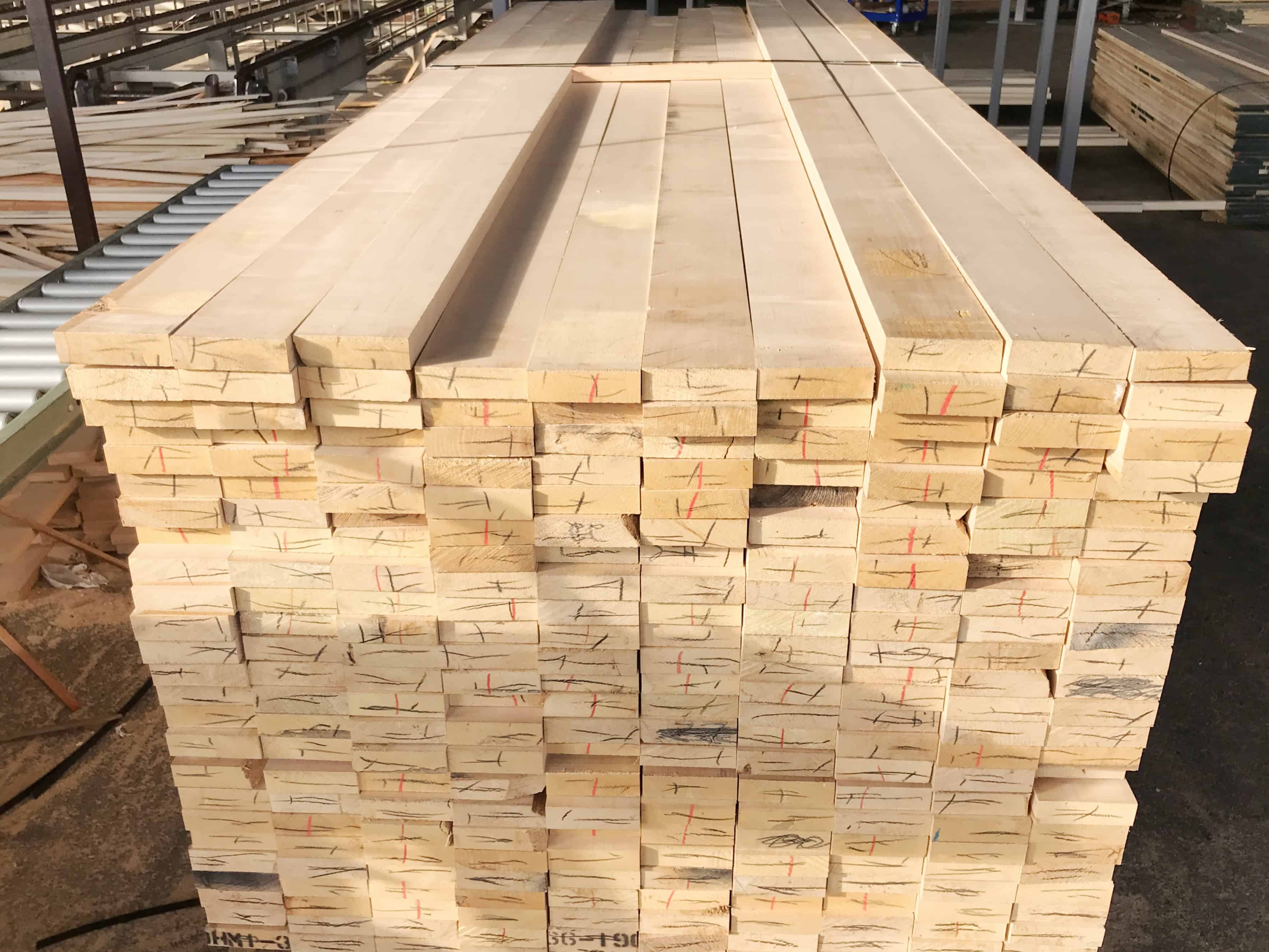
Hard Maple Data
| Scientific Name | Acer saccharum |
|---|---|
| Common Names | Rock Maple, Sugar Maple, White Hard Maple |
| Family | Sapindaceae |
| Genus | Acer |
| Higher Classification | Oleeae |
| Rank | Species |
| Kingdom | PLantae |
| Region of Origin | Appalachian, Canada, East Coast, Mid West, North America, Northern, United States |
| CITES Appendix | No |
| IUCN Red List of Concern | No |
| Durability | High |
| Density | High |
| Janka Rating | 1450 |
| Scent | None |
| Average Weight (LB) per Board Foot (KD) | 4.25 |
| Average Board Width (inches) | 6.75 |
| Average Board Length (feet) | 9.5 |
| Average Tree Diameter (inches) | 30 |
| Average Tree Height (feet) | 95 |
| Texture | Fine, Hard, Uniform |
| Heartwood Color | Brown, Red |
| Sapwood Color | Cream White, Pale, White |
| Grain Type | Fine, Slight, Uniform |
| Heart/Sap Distinction | Strong |
| Drying Difficulty | High, Medium, Prone to sap stain |
| Commercial Availability in US | High |
| Cutting Ease | High, Machines well, Medium, Prone to knife burn |
| Glue Difficulty | Adheres well, Low |
| Color Tone | Calico, Mixed |
| Stability | High |
| Finish Difficulty | High, Medium, Prone to absorbing finishes at an uneven rate, Prone to absorbing finishes unevenly |
| Thickness Availability | 10/4, 12/4, 4/4, 5/4, 6/4, 8/4 |
| Plain Sawn Availability | Yes |
| Quartersawn Availability | Yes |
| Live Sawn Availability | Yes |
| Veneer Availability | Yes |
| Grades Available | #1 Common, #2 Common, FAS, Frame, Select |
| Milling Available | Edge Glue, Gang Rip, Rough-sawn, S2S, SL1E, SL2E |
| Millwork Wood | Yes |
| Birdseye Figure | Rare, Yes |
| Curl Figure | Rare, Yes |
| Quilt Figure | No |
| Flame Figure | Rare, Yes |
| Furniture Wood | Yes |
| Turning Wood | Yes |
| Flooring Wood | Rare |
| Guitar Wood (Acoustic) | Yes |
| Guitar Wood (Electric) | Yes |
| Price | $, $$ |
| Similar Species | Birch, Alder, Cherry, Poplar |
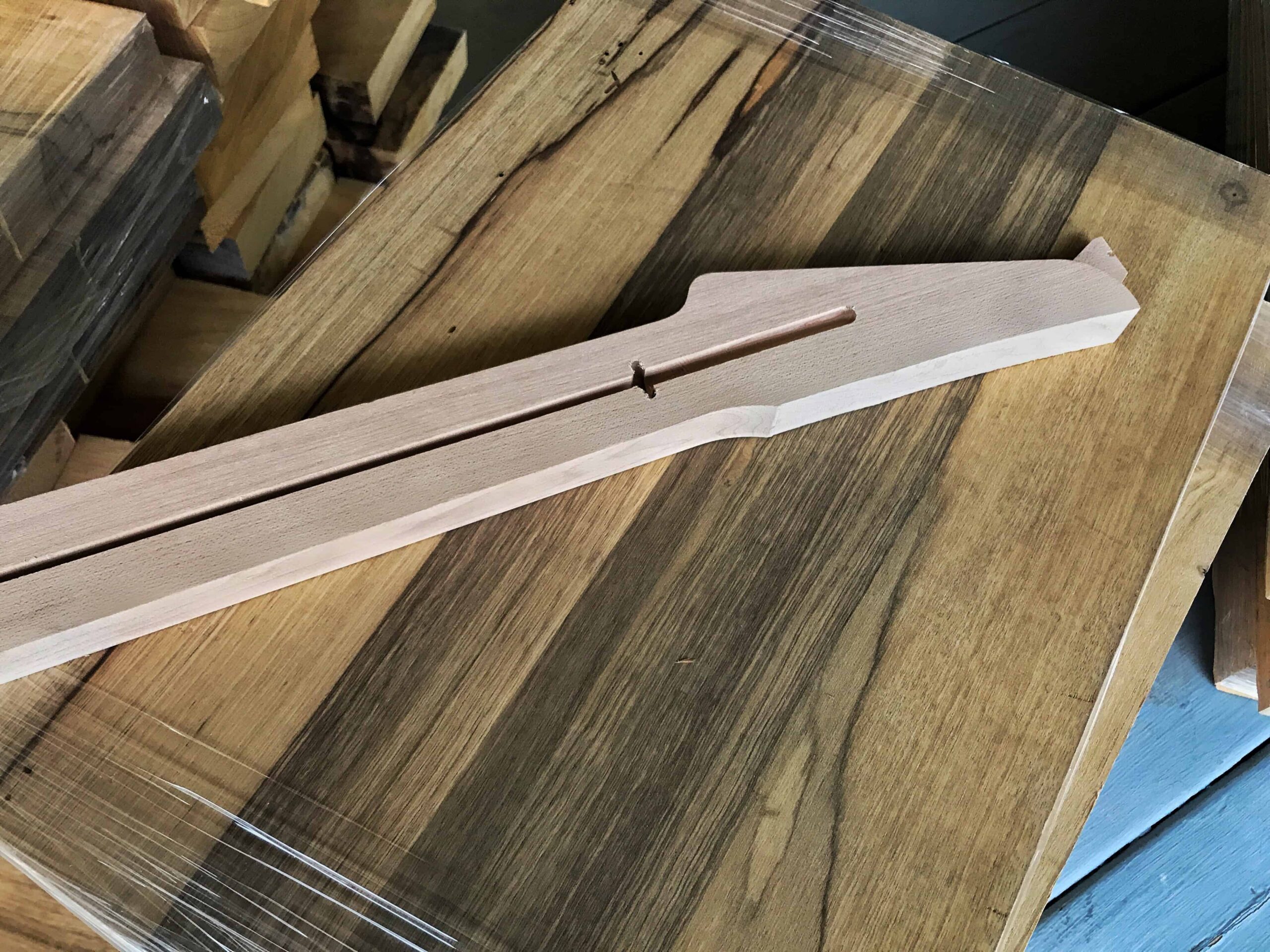
North American Hard Maple Production
Most of the hardwood maple lumber produced at US sawmills is flat-sawn (or plain-sawn). This method efficiently produces marketable boards with growth rings that run mostly horizontal. Thus, the result is an open grain appearance.
Quartersawn Maple is often used to make fretboards, guitar necks and fingerboards in the music industry, as well as cue sticks for billiards/pool/snooker.
Conversely, Quartersawing maple produces hardwood with mostly vertical or close to vertical grain lines. Significantly, only a few industries require maple in QS grain orientation. The most common applications include maple hardwood flooring and guitar neck blanks, even spoon carving! . In addition to the visual appeal of QS grain, it provides extra stability within the wood. Roasting is another method to improve wood stability.
Where Does Quartered Maple Come From?
Most QS Maple comes from the Northern or Northern Appalachian region. The reason for this is because the highest quality maple logs are grown in these areas. In theory, any log can be quartersawn, regardless of its region of origin. However, the quarter-sawing process is less efficient and more expensive than plain-sawing. Also, there is a substantial difference between the price of FAS and lower grades of QS Maple. Thus, returns are disproportionately higher on top quality logs than average or low quality logs.
A cold weather environment promotes maple quality in two ways:
- Trees grow slower, resulting in dense fiber and tight growth rings.
- In cold weather, Maple sapwood maintains its white color after sawing. Whereas, warm weather expedites sap stain or blue stain. Accordingly, long cold winters and short summers provide ideal growth conditions for white woods like maple.
United States Forest Service on Maple Migration
Interestingly, maple is migrating North for those very reasons. Here is what the United States Forest Service reported in 2013:
With large areas of our planet heating up because of climate change, some trees (and plants) are pulling up roots and heading north, to higher elevations and to cooling climes—well, sort of.
A U.S. Forest Service-led study suggests there are a few dozen tree species in the eastern U.S. that are moving north at an unexpected rate.
“For some plants and trees, moving north is real and their only chance for survival,” said Chris Woodall, a research forester for Northern Research Station and the study’s author. “Our study confirms a link between global warming and forest migration. It’s no longer conjecture.”
In fact, some tree species may be able to migrate from their home range more than 60 miles in a century. That could mean the yellow birch from the eastern U.S. might cross into Canada by the early 2100s. Other trees that are moving north or to higher elevations include the northern white cedar, American basswood, sugar maple, black ash and bigtooth aspen.
Trees depend on wind currents, birds or other animals to transport their seeds. Now seeds deposited in northern ranges, that were once too cold for these species, have also warmed and are now suitable for some migrating trees and plant species to take root.
Another study led by the University of Arizona found Alligator juniper at an elevation of 3,500 feet in the upland desert and grasslands of the Catalina Mountains near Tucson. Today, you won’t find the first stands of alligator junipers until you reach 5,000 feet.
source: Stancil, J (3 December 2013) These Trees Were Made for Walking. https://www.fs.fed.us/features/these-trees-were-made-walking
Quartersawn is a Woodworking Term
Quartersawn is a woodworking term that describes a method for sawing lumber from logs. In this method, the log is split into 4 pie-shaped sections, hence the term quarter.

Because the grain runs in a circular pattern around the log, the front and back face of each pie show mostly straight grain lines. However, grain lines do not always run in nice uniform circles around the log. Boards are sliced off the face of the pie with each piece yielding straight grain lines.
Four Observations on Quartersawn Maple:
- Because the quarter-sawing process begins by splitting the log into four equal pie-shaped sections, smaller lumber boards are produced than when plain-sawing.
- Grain rings around the tree are not typically uniformly circular. Thus, areas within the same board may exhibit both quartered and plain saw grain.
- Heartwood and sapwood considerations can make quarter sawing high grade lumber with good color and width difficult.
- At the end user level, quarter-saw is often looked at in terms of the finished product rather than a process. Whereas the sawmill refers to a process. For example, when a run of maple logs is quartered at the mill, most but not all of the boards come off the saw with a straight grain, traditional QS look.
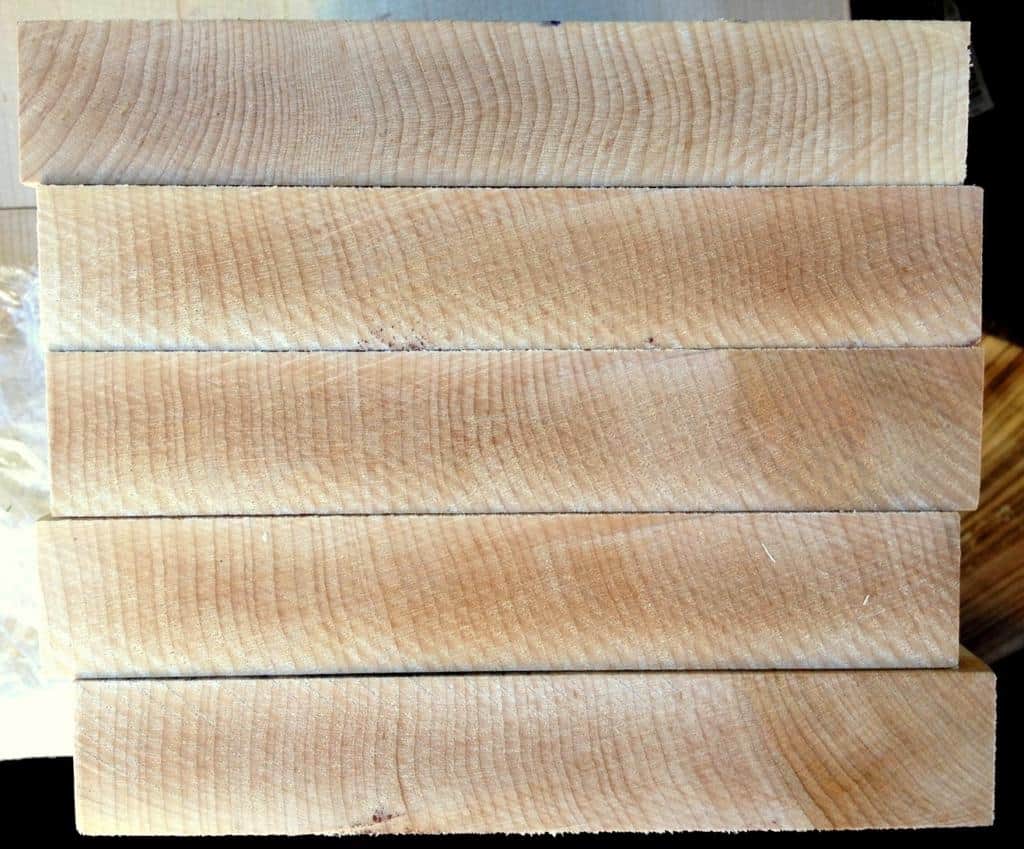
Quarter Saw Milling Can Produce Plain Saw Lumber Boards
A common complaint with quarter sawn lumber purchases is that some of the wood is flat-cut. The simple reason for this is that the supplier and customer have different definitions for “quartersawn.”
- Supplier’s definition is any wood resulting from the quarter-sawing process. This includes the roughly 20-30 % of developing plain-saw boards. This definition is typically used by lumber industry professionals only.
- Customer’s definition is wood that has vertical or close to vertical grain-lines. By this definition, the sawing method (quarter sawing, rift sawing, plain-sawing, live-sawing, etc.) is irrelevant. Vertical grain lines on the face and back of the final product is the sole criteria.
Is Quartersawn Maple the Best Wood for Electric Guitar Necks?
Many luthiers believe that QS Maple is the best wood for electric guitar necks. However, others believe that less dense woods such as mahogany, sapele and limba, perform equally well as neck blanks. Alternatively, some luthiers prefer maple but use flat-sawn maple or plain-sawn maple for their grain orientation.
There are three reasons that luthiers choose QS maple for neck production.
- Tradition. Fender Guitars set the standard for single piece bolt-on maple electric guitar necks decades ago. Guitarists are notoriously fond of vintage specs and resistant to major design changes. If you are designing a vintage-style Stratocaster or Telecaster, you need a maple neck.
- Stability. Certainly, Sugar Maple has a high density. Using a quarter sawn grain orientation ensures uniformity of movement when it occurs. Both factors keep guitar neck movement to a minimum. Accordingly, guitar manufacturers have fewer intonation issues as a result of neck instability.
- Appearance. Bright white sapwood in Hard Maple has a clean appearance. Additionally, quartersawn grain lines give the neck sleek uniform racing stripes. It’s similar to the pinstripes on a New York Yankees home uniform. It just looks sharp!
Is Flame Maple Quartersawn?
Curly and Flamed are two ways of describing the same maple figure. When maple is quarter-cut the figure appears as vertical flame lines. The same appears in Koa wood. However, the same figure appears curly when viewed on plain-sawn grain.
In truth, the same vertical flame lines appear when quartersawn or plain-sawn. However, the figure distorts the grain-lines when plain-sawn. Thus, your eye is drawn to the curving grain lines. With Quarter-sawn, the grain lines shift only slightly, if at all. Therefore, your eye is drawn to the flame figure only.
To verify find a board of Curly Soft or Hard Maple. Next, turn the board on its side to view the end-grain. You will see the flame figure there.
This phenomenon is also found with Birdseye maple figure. However, with Birdseye, the eyes appear open when plain-sawn and closed when Quartersawn.
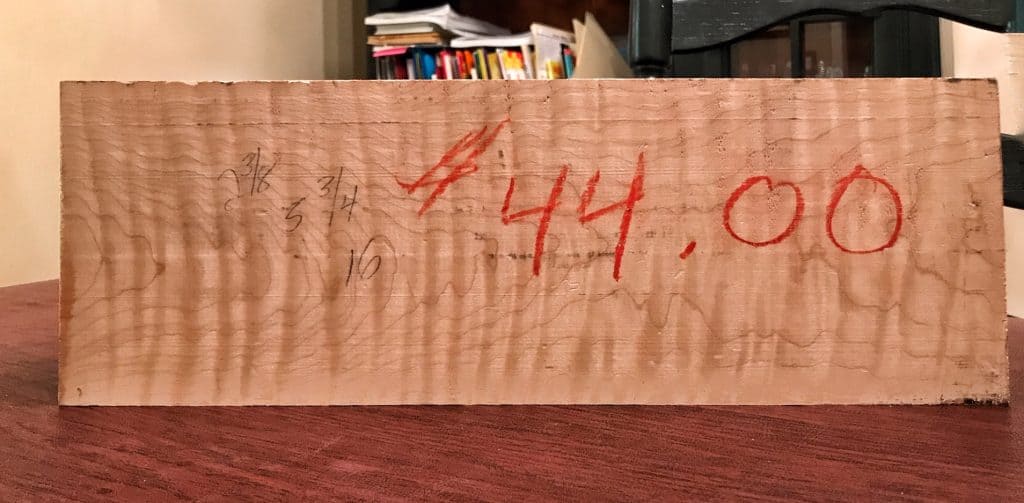

Quarter-sawn Maple Flooring
Does Maple need to be quartersawn for flooring applications? Maple is a relatively stable flooring wood, generally speaking. Accordingly, flooring manufacturers mostly use plain-sawn maple.
However, there are 4 reasons why designers and architects request quartersawn maple flooring instead of plain-sawn:
- Stability. A quartersawn hardwood floor is less prone to movement than one that is plain-sawn. With Sugar Maple, the stability gain is marginal. However, it also provides peace of mind to the designer and homeowner. Using QS Maple conveys the importance placed on flooring stability.
- Uniformity. Quarter sawn maple adds straight vertical grain lines to the floor’s appearance. Typically these are easy to match from plank to plank. It’s a clean modern look that is popular in design.
- Quality. Generally speaking, high quality maple logs are used in the quartersawing process. This is due to the inefficiency of quarter-sawing as well as the lack of low-grade quartersawn maple markets. Thus, quartersawn maple flooring is usually on the upper end of the hardwood flooring grade spectrum.
- Exclusivity. As stated previously, quarter-sawn maple is produced in lower quantities than flat-sawn maple. Additionally, board widths run narrower than plain-sawn maple. Thus, a homeowner with wide width quartersawn plank maple flooring belongs to a select group. You cannot find maple flooring like that in big box stores or chain flooring liquidators.
QS Maple Appearance
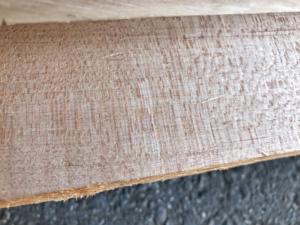
What is flecking in wood?
Properly quartered wood with 90 degree grain angles often exhibits medullary ray fleck. Ray flecks are often clearly visible in quartered white oak flooring. Medullary ray fleck is a conspicuous figure. It is easy to distinguish from regular grain patterns especially after the wood is finished.
Here is how University of Wisconsin-Madison Professor Emeritus Gene Wengert describes wood fleck:
Most of the small wood cells in a tree run up and down (or vertically) in the stem, conducting fluids from the roots to the leaves. A few cells run in and out from the bark to the center of the stem (or horizontally or radially). These cells, that primarily store starches and sugars in the tree, are called ray cells or sometimes ray parenchyma cells. With a flatsawn piece of lumber, the ends of the ray cells (the ends appear like the cut ends of a handful of soda straws) are exposed on the face of the lumber and generally do not have too much of an effect on the appearance of the face: short vertical lines, if any effect. However, on quartersawn lumber, the sides of the ray cells are running parallel to the face. This side view creates an interesting pattern in many species of hardwood lumber, including maple, oak, sycamore and beech. This side view or appearance of the ray cells in quartersawn lumber is called ray fleck. In fact, the standard definition of quartersaw or riftsawn lumber for many species is that the ray fleck must be obvious.
source: Wengert, G (23 March, 2011. Looking at Ray Fleck. https://www.woodworkingnetwork.com/magazine/fdmc-magazine/looking-ray-fleck
Quarter-sawn Wood Has More Exposed Medullary Rays Than Rift
For a straight grain line appearance without ray flecks use rift cut wood. The slight off-set from vertical grain leaves the medullary rays unexposed on the face of the wood.
Generally speaking, QS maple ray flecks are not as prominent as the flecks found in oak. Also, the fleck appearance is different. In my experience, maple boards need to be extremely close to 90 vertical grain to show good medullary ray figure. Whereas, oak rays seems to have a higher tolerance for slightly off-perpendicular grain.
Quarter Cut Heartwood and Sapwood Considerations for Maple
High quality Hard Maple logs have a small heartwood center surrounded by a large sapwood area. Of course, lower quality logs can be quartersawn but the resulting lumber will contain traditionally undesirable characteristics like heartwood, narrow widths, etc. Typically, the negative attributes of producing low grade QS maple outweigh any benefits gained from the vertical grain orientation. Accordingly, it makes economic sense to only use high quality (expensive) saw logs when quarter-sawing hard maple.

Quartersawn European Sycamore is also Called Quartersawn European Maple
Quartersawn European Sycamore is sometimes referred to as European Maple. Consequently, it causes confusion among figured wood buyers.
American Sycamore is not a maple wood but the European variety is.
Therefore, make sure you specify the country of origin when requesting sycamore. Both American and European QS Sycamore have excellent figure. However, if you are looking for heavy medullary rays, you will find more pronounced figure in American Sycamore than European Sycamore.
Rift Sawn Maple
Rift sawn is our least requested maple grain-orientation. Most of our maple customers specify either plain-sawn or quartersawn. We do supply rift but the demand is sporadic. Rift-sawn maple has a very similar face-grain appearance when compared to quartersawn.
Typically, there are few medullary rays on the face of rift-sawn maple. The end-grain of rift-cut maple shows a diagonal end-grain pattern, rather than the vertical or horizontal exhibited by quartersawn and plain-sawn.
Often, the diagonal end grain of rift sawn maple makes grain-matching more difficult than quarter-cut or flat cut grain. However, this is up to the preference of the luthier or woodworker.
Contact Us For Your Quartersawn Maple Needs.
We are the premier supplier of QS Sugar Maple lumber and component parts in the Western United States. Established end users often wonder where to buy quartered maple. Very few lumber companies even stock quarter-cut maple. We accept custom wood orders for the following specifications :
- All white sapwood color, one or both faces
- Lumber widths up to 10″ wide
- Off-vertical grain tolerance limitation
- Engineered flooring lamellas (skins) from 3mm-6mm thick x up to 10″ wide
- Lumber thicknesses of 1/2, 4/4, 5/4, 6/4, 8/4
We can help you with your QS Maple project.
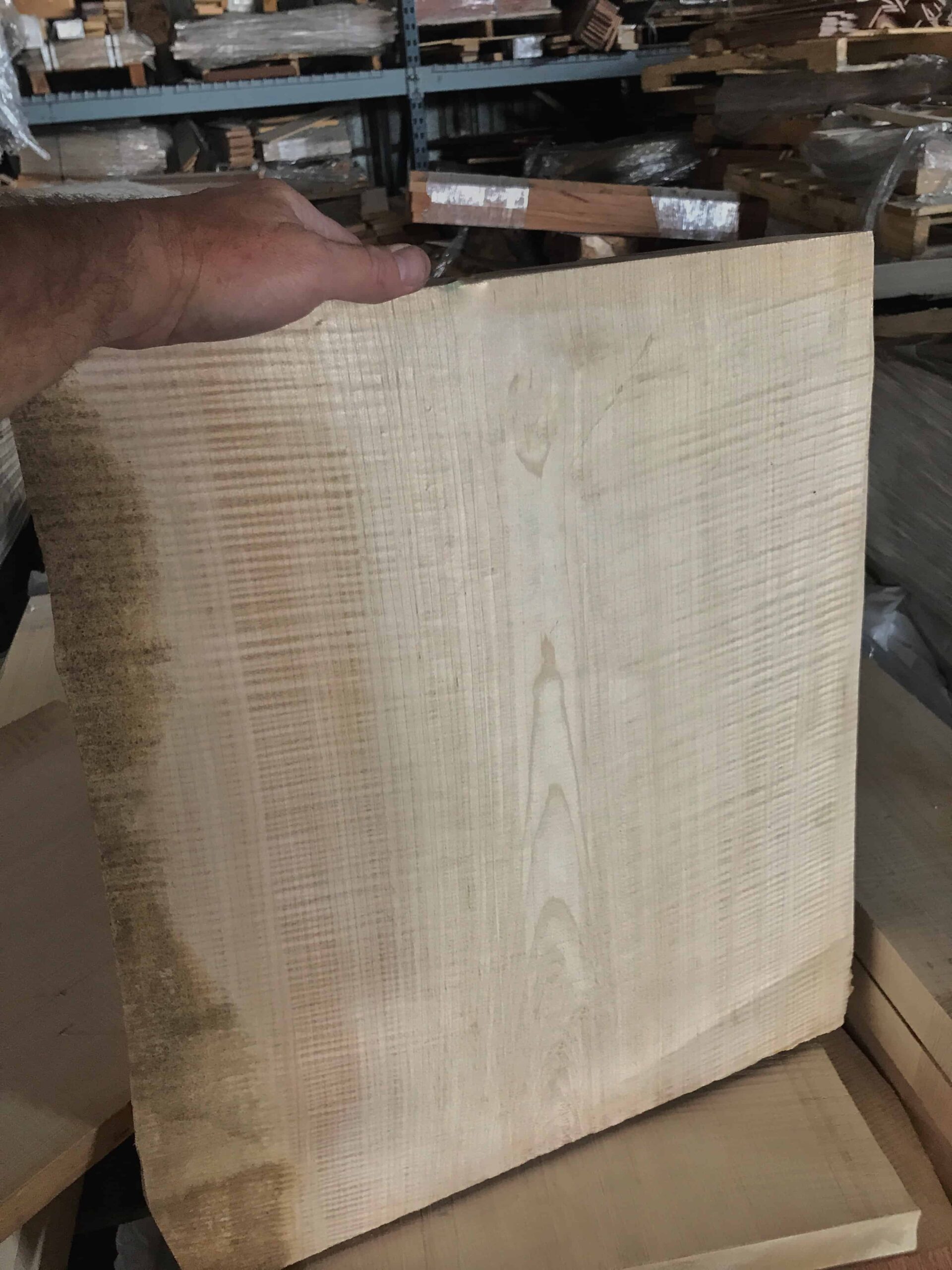
21 thoughts on “Quartersawn Maple: A Helpful Illustrated Guide 2024”
Comments are closed.

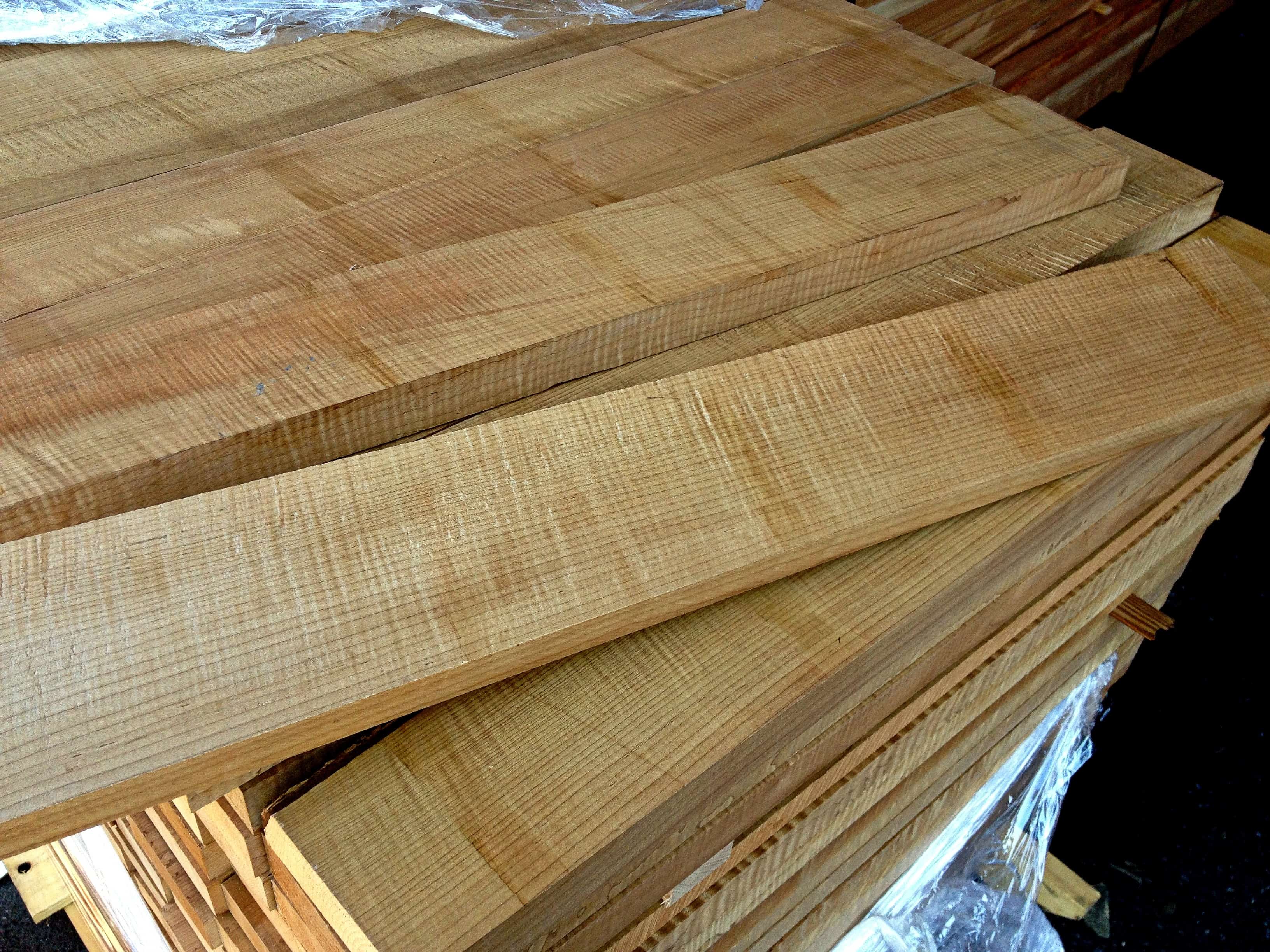
Pingback: Import Wood End Checking: How to Prevent - Commercial Forest Products
Pingback: 🌳 White Limba/Korina: Lumber & Guitars - Commercial Forest Products
Pingback: 🌳 Good Genuine Mahogany - Where is it? - Commercial Forest Products
Pingback: Rustic Wood Paneling for Restaurant Interior Design - Commercial Forest Products
Pingback: 🌳 Cary Nordstrand Sound Secrets - Commercial Forest Products
Pingback: Roasted Maple: Guitar Neck Wood Guide - Commercial Forest Products
Pingback: Birdseye Maple Lumber - Commercial Forest Products
Pingback: Best Wood for Wands - Commercial Forest Products
Pingback: Quarter Sawn Ash Lumber - Commercial Forest Products
Pingback: Chatoyancy - What is Chatoyance in Figured Wood? -
Pingback: Los Angeles Lumber -California - Commercial Forest Products - 2020
Pingback: Quartersawn Walnut Lumber - Commercial Forest Products
Pingback: QUARTERSAWN POPLAR Lumber | WOOD - Commercial Forest Products
Pingback: Quartersawn Mahogany - Commercial Forest Products
Pingback: Engineered Walnut Flooring | Width Width Quartersawn - Commercial Forest Products
Pingback: Engineered Quartersawn Walnut Flooring | Wide Width - Commercial Forest Products
Pingback: What Does Quarter Sawn Wood Mean? - WoodWorks Hub
Pingback: Wood: What Is It? - Commercial Forest Products
Pingback: Spalted Wood ~ Spalting Lumber 2022 - Commercial Forest Products
Pingback: 8/4 Maple Quartersawn Lumber: 6 Reasons It's RARE! - 2022
Pingback: How To Tell Honduras Mahogany From African? 2023 - Commercial Forest Products